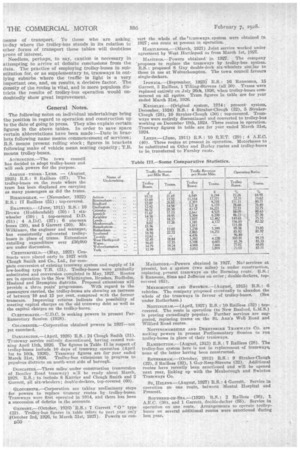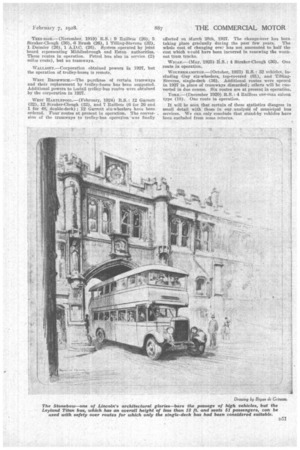TROLLEY-BUS OPERATION.
Page 123

Page 124

Page 125

If you've noticed an error in this article please click here to report it so we can fix it.
A Complete Survey of the Trolley-bus Systems in Great Britain, with Comparative Statistics of Electric Tramways.
TE first trolley-bus sy.stems in this country began to work in June, 1911, the pioneer authorities being the Leeds and Bradford Corporations. To-clay there are 21 systems at work (20 owned by local authorities and 1 by a company).
Table I gives a complete list of these, showing the total route mileage at present operated and the number of trolley-buses in service. The table also gives, under similar headings, particulars of electric-tramway systems in operation by the same authorities, which enables a comparison to be made of the relative sizes of• the systems. It will be noticed that in six instances the tramway systems have been entirely discontinued, and that in two other cases no electric tramways have been constructed.
Eighteen other local authorities and one company possess the necessary statutory powers to instal sysitems, most of which are, at the moment, dormant, but a few are under construction or under active consideration, and thd proposals in connection with these are referred to in the general
• notes on the individual undertakings given later. To complete the list of undertakings authorized, it may be noted that five local authorities and one company have constructed systems and subsequently ilisccetinued them, whilst seven local authorities and two companies obtained powers but allowed them to lapse.
New powers are being sought in the present Parliamentary session (1928) by Rotherham and Wolverhampton for extensions. and by Accrington Corporation, Cleethorpes Gloucester Corporation and the Nottinghamshire and Derbyshire Tramways Co. to use trol ley vehicles in place of existing tramways anti light railways.
Aggregate Figures of Trolley-bus Working.
The latest figures show that, during the year ended March 31st, 1927, the trolley-vehicle systems then working (19 local authorities and 1 company) carried 50,382,193 passengers; ran 253 buses 5,092,956 miles over routes totalling 47.04 miles at an average speed of 7.83 car miles per car hour ; consumed 7,566,147 units of electricity ; expended a total of £249,955 in working ( = 11.78d. per mile run) ; earned a total income of £286,391 ( =13.50c1. per car mile run) ; and made a gross profit of £36,436 to meet interest, redemption and other charges on a net capital liability of £515,650.
It will be interesting now to consider the individual systems and to compare them with the tramway systems operating in the same districts. This can be most conveniently done in tabuolleyvehicle Systems in lar form, and Table II sets out the principal operating data, The figures given in the table are also
anuary, 1928. Tramway Systems for the year ended March 31st, 1927, both for trolley vehicles and tramways, except in the case of the tramway figures for Darlington and Ipswich (in which instances the figures are for the year ended March 31st, 1926), and Keighley (where the figures given are for the year ended March 31st, 1924). These are the last complete years of tramway operation. The same remarks apply to Table 'HI, which shows some interesting calculations based upon the operating data, and enables comparisons to be made between the respective
Route Mileage.
8.20 39 77.78 713 58.85 250 Discontinued. Discontinued.
2.86 32 Diseon inued. Discontinued. Discon inued.
69.73 437 6.48 18 24.55 2(0 No TrarnwaYs.
10.59 38 17.28 38 8.54 58 No Tramways. Discon inued.
20.22 78 8.46 29 8.49 37
(Electric).
No. of Cars.
means of transport. To those who are asking to-day where the trolley-bus stands in its relation to other forms of transport these tables will doubtless prove of interest.
Needless, perhaps, to say, caution is necessary in attempting to arrive at definite conclusions from the data. The practice of employing trolley-buses in substitution for, or as supplementary to, tramways in outlying suburbs where the traffic is light is a very important one, and, on results, a decisive factor. The density of the routes is vital, and in more populous districts the results of trolley-bus operation would undoubtedly show great improvement.
General Notes.
The following notes on individual undertakings bring the position in regard to operation and construction up to the date of going to press. They also explain certain figures in the above tables. In order to save space certain abbreviations have been made :-Date in brackets following name means commencement of services; R.S. means present rolling stock ; figures in brackets following make of vehicle mean seating capacity ; T.B. means trolley-buses.
ACCRINGTON.-The town council has decided to adopt trolley-buses and will seek powers for the purpose.
ASHTON UNDER LYNE. (August,
1925) R.S.: 8 Railless (37). The trolley-buses on the route where the tram has been displaced are carrying as many passengers as did the trams.
BIRMINGHAM. (November, 1922) 11..8.4 17 Railless (51) ; top-covered.
BRADFORD.-(June, 1911) R.S. 10 Brown (Huddersfield) (30) : 1 sixwheeler (59) ; 1 top-covered D.D. (51) ; 4 A.D.C. (37) ; 6 one-man buses (30), and 5 Garrett (30). Mr. Wilkinson, the engineer and manager, has consistently advocated trolley-, buses in place of trams. Extensions entailing expenditure over £20,000 are under discussion..
CianstEarmn.-(May, 1927) Contracts were placed early in 1927 with Clough Smith and Co., Ltd., for complete conversion of existing tramway system and supply of 14 low-loading type T.B. (31). Trolley-buses were gradually substituted and conversion completed in May, 1927. Routes are in operation inthe New Whittington, Brushes, Buclholm, Hasland and Brampton districts. Proposed extensions will provide a thrae years' programme. With regard to the passengers carried, the trolley-buses are showing an increase of between' 10 and 15 per cent, compared with the former tramcars. Improving returns indicate the possibility of meeting capita charges on the old tramway debt as well as the capital charges on the trolley-buses.
• •
COLCHESTER.-Corporation obtained powers in 1027-not yet exercised.
Danttuaroie.-(April, 1926) R.S.: 24 Clough Smith (31). Tramway service entirely discontinued, having ceased running April 11th, 1926. The figures in Table II in respect (.1 trolley-buses include 10 days of tramway operation .(April 1st to 10th, 1926). Tramway figures are for year ended March 31st, 1926. Trolley-bus extensions in progress to populous districts on north-west side of borough.
DONCASTER.-Three miles under construction (conversion of Bentley Road tramway) will be ready about March. 1928. R.S.: to include 8. Karrier and Clough Smith and 2 Garrett, all six-wheelers; double-deckers, top-covered (60).
GroucEsrm.-Corporation are taking preliminary steps for powers to replace tramcar routes by, trolley-buses. Tramways were first operated in 1914, and there has been a succession of deficits in the accounts.
ORTMSBY.-(October, 1926) 7 Garrett "0" type (32). Trolley-bus figures in table relate to part year only i(October 3rd, 1920, to March 31st, 1927). PowerS to con.1)50
vert the whole, of the 'tramways, system were obtained in 1927; one route at present in operation.
HARTLEPOOL.-(March, 1927) Joint service worked under agreement by West Hartlepool as from March 1st 1927.
HASTINGS.-Powers obtained• in 1927. The company 'proposes to replace the tramways by trolley-bus system. R.S.: proposed 8 Guy double-deck six-wheelers similar to those in use at Wolverhampton. The town council favours single-deckers.
Ipswacn.---(September, 1923). R.S.: 16 Ransomes, 15 Garrett, 3 Railless, 1 Tilling-Stevens (all 30). Trams were replaced entirely on July 26th, 1926, when trolley-buses commenced on all routes. Tram figures in table are for year ended March 31st, 1926.
KEIGHLEY.-(Original system, 1014; present' system, December, 1924) R.S.: 4 Straker-Clough (32), 5 StrakerClough (28), 10 Straker-Clough (50) ; top-covered. Tramways were entirely discontinued. and converted to trolley-bus working on December 19th, 1924. Three routes in operation. Tramway figures in table are for year ended March 31st, 1924.
Lemns.-(June, 1911) R.& : 1.0 R.E.T. (29) ; 4 A.E.C. (40). Three routes at present in operatiOn. Motorbuses to be substituted on Otley and Burley routes and trolley-buses to be transferred to Fernley route.
IVIAtosroNE.-Powers obtained in 1927. NW -services at present, but asystem (two miles) is under construction, replacing present tramways on the Barming route. R.S.: 8 Ransome, Sims and Jefferies on order ; double-deckers, top-, covered (63).
MEXBOROUGH AND SWINTON.(August, 1915) R.S.: 6 vehicles. The company proposed eventually to abandon the whole of the tramways in favour of trolley-buses. (See under Rotherham.)
NoxmenAm.-(April, 1927) R.S. : 10 Railless (52) ; topcovered. The route in operation (to New Bedard, H.1$1.S.) is proving exceedingly popular. Further services are suggested,' replacing trams on the St. Ann's Well Road and Wilford Road routes.
NotriNcistAmsninT AND DERBYSHIRE ri`RAMWAYS CO. are seeking powers in present Parliamentary Session to run trolley-buses in place of their tramways.
ItAMSBOTTOM.-(August, 1913) R.S.: 7 Railless (28). The trolley-bus system here is not in replacement of tramways, none of the latter having been constructed.
BOTHERHA11.-(October, 1912) R.S.: 9 Straker-Clough (32), 3 Railless (32), 1 Guy-Rees-Stevens (32). Additional routes have recently been sanctioned and will be opened next year, linking up with the Mexborough and Swinton Tramways Co.
ST, HELENS.(August, 1927) R.S.: 4 Garrett. Service in operation on one route, between Mental Hospital and Prescott.
SOUTHEND-ON-SEA.-(1926) R.S.: 2 Railless (36), 1 A.B.C. (30), and 1 Garrett, double-decker (55). Service in operation on one route. Arrangements to operate trolleybuses on several additional routes were sanctioned during last year. TEES-SIDE.----(November, '1919) KS.: 0 Rai.Hess (26), 5 Straker-Clough (26), 6 Brush (26), 1 Tilling-Stevens (32), 1 Daimler (26), 1 A.D.C. (26). System operated by joint board representing Middlesbrough and Eaton authorities. Three routes in operation. Petrol bus also in service (24:, mil'm route), but no tramway.
-WALLASEL—Corporatiort . obtained powers in 1927, but the operation of trolley-buses is remote.
WEST BROIRVTICH.—ThC purchase of certain tramways and their replacement by trolley-buses has been suggested. Additional powers to thstall trolley-bus routes were obtained by the corporation in 1927.
WEST 11AnTr.spoot.—(Fehruary, 1924) R.S.: 12 Garrett (32), 12 Straker-Clough (32), and 7 RailleSs (6 for 36 and 1 for 48, double-deck) ; 12 Garrett six-wheelers have been ordered. Four routes at present in operation, The conversion of the tramways to trolley-bus operation was finally
effected on March 28th, 1027. The change-over has been taking place gradually during, the past few years. The whole cost of changing ove7 has not amounted to half the cost which'scold have been incurred in renewing the wornout tram tracks.
I.V.to..i.m.—(May, 1925) 4 Straker-Clough (36). One route in operation.
WOLVERHAMPTONT.—(October, 1922) R.S. : 32 vehicles, including Guy six-wheelers, top-covered (61), and TillingStevens, single-deck (36). Additional routes were opened in 1927 in place of tramways discarded; others will be converted in due course. Six routes are at present in operation.
Iona.—(December 1920) R.& : 4 Railless one-man saloon type (18). One route in operation.
It will be seen that certain of these statistics disagree in small detail with those in our analysis" of municipal bust service& We can only conclude that stand-by vehicles have been excluded from some returns.




















































































































































































































